Best Pet Toads For Beginners
The best pet toads are the ones that look the coolest, are hardy, and don’t need a massive setup.
Below are the top 7 toads that we think make great pets, if you’re into that sort of thing. They are each categorized by beginner, intermediate, or expert levels.
Toads have vibrant colors, love to climb, jump, and swim. All of which can be entertaining to watch.
It’s one thing to keep in mind if you are looking at a pet toad or even a pet frog. They are display pets and really aren’t meant to be handled.
Quick Reference Section
1. California Toad

Quick Facts
- Experience Level: Beginner
- Family: Bufonidae
- Scientific Name: Anaxyrus boreas
- Common Names: Western toad
- Average Adult Size: 2.25- 2.5 inches
- Lifespan: 5 years
- Average Price Range: $10- $20
Quick Care Requirements
- Food: Fish food pellets, Blood worms, Shrimps
- UVB Lighting: Low-Level UVB required
- Minimum Aquarium Size: 10 gallons
- Temperature Range: 65ºF to 82ºF (Water Temperature)
They are yellowish-green colored. Californian Toads don’t like being handled and will generally release a mild toxic secretion while being held. If you are going to handle one you should wear chemical free latex gloves or similar.
It’s important to bear in mind that they absorb through their skin, so lotion, cleaners, etc can all be a danger for amphibians in general.
They should be fed daily when they are small and once they are adults can be fed twice or three times a week.
For their enclosure you can use coconut fiber as a substrate and add some bark or similar natural items to spruce up the place. Hiding spots are always an important thing as well.
Humdity levels should be at least 60% or higher. They are active at night. If they show inactivity, bloated stomach lethargy, weight loss, take them to veterinary.
2. Cane Toad
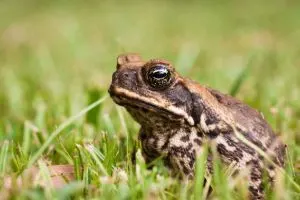
Quick Facts
- Experience Level: Beginner to Intermediate
- Family: Bufonidae
- Scientific Name: Rhinella marina
- Common Names: Giant neotropical toad, Marine toad
- Average Adult Size: 4-6 inches
- Lifespan: 15-25 years
- Average Price Range: $15-$20
Quick Care Requirements
- Food: Brown Crickets, Fuzzies, Small rodents, Big Insects
- UVB Lighting: Not required
- Minimum Tank Size: 20 gallons
- Temperature Range: Minimum 75º F
If you want a large pet frog, this is the go-to choice. The Cane Toad is huge with olive green color. Suitable for those who are new to petting frogs. With proper diet and care, they can also live up to 25 years. They are mediately active and are low maintenance.
It’s not suggested to keep two males in the same tank as they are territorial animals. Be careful when handling them with caution as they might try to escape and in the process get injured. As mentioned about you should avoid handling them for the most part anyways.
A beach like setup is something they will really enjoy. You can put stones in the aquarium and fill it about one-third of the way with dechlorinated water.
Tank cleaning should be done regularly around 1 to 2 times a week. Filtration systems can help a lot with that. Moss and bark are nice accessories and if needed you should also have a heater to ensure the climate is correct.
You can keep them in direct sunlight, but they should also have a place they can go outside of the sun if they get too warm. If you do place them in direct sun, you need to monitor the temperature very closely.
You don’t want to bake them alive in the enclosure. Generally speaking a best practice is to keep them out of direct sunlight and to use a basking light as an artificial alternative which you can control better.
See our Cane toad care guide for more.
3. Bumblebee Dart Frog (Classified as toad)
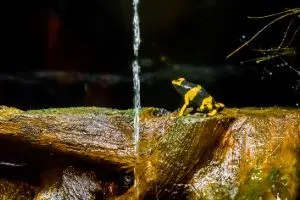
Quick Facts
- Experience Level: Expert
- Family: Dendrobatidae
- Scientific Name: Dendrobates leucomelas
- Common Names: Yellow banded poison frog, Yellow-headed poison frog
- Average Adult Size: 1.5 inches
- Lifespan: 10-15 years
- Average Price Range: $45-$75
Quick Care Requirements
- Food: Fruit Flies, Small Crickets
- UVB Lighting: Required
- Temperature Range: 75⁰-80⁰(Day), 70⁰ (Night)
- Aquarium/Tank Size: 15-20 gallons (for a couple)
Bumble bee dart frogs which are classified as toads are colored very vibrantly. This makes them very appealing since they are the perfect display pet.
Color wise they will have a very black skin with highly contrasting bright yellow.
As with the other toads you should be avoiding handling them and if you do, wear gloves, and always wash your hands with warm soap and water before and after.
Like their name suggests they are poisonous, so you definitely want to avoid ingesting anything they may secrete on you or your gloves.
While they aren’t deadly, their venom can cause a mild reaction on your skin.
When it comes to their colors, females will have more pronounced colors than males.
As with most amphibians, humidity levels should be kept high. Decoration wise, live plants are a great option for the environment and for holding in moisture.
Tap water is generally not usable due to all the chemicals in it, so you should be using dechloronated water for them. Water should be replaced daily to ensure they always have fresh water available.
Misting systems are a good option to simylate rain and to keep the humidity up as well.
4. American Toad
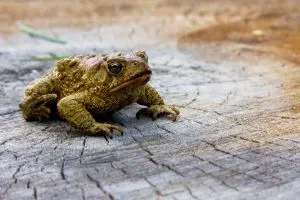
Quick Facts
- Experience Level: Beginner
- Family: Bufonidae
- Scientific Name: Anaxyrus americanus
- Common Names: American Toad
- Average Adult Size: 2-3.5 inches
- Lifespan: 15 years
- Average Price Range: $10
Quick Care Requirements
- Food: Small insects, Earthworms
- UVB Lighting: Not required
- Temperature Range: 60⁰-70⁰
- Aquarium/Tank Size: 10 Gallon tank
The American Toad has a cool feature in that when they are under stress, their skin color changes from brown to green to yellow.
Similar to the bumblebee frog they have a chemical called bufutoxin, which will irritate your eyes. So again, caution when handling, but try to avoid it.
As usual dechlorinated water should be used in their aquarium with one side remaing dry and the other moist.
American Toads are nocturnal like many of the others which just meand they are active during nights.
If they become stressed or just generally show weightloss, have parasites, are excessively yawning, are breathing in a distressed way, or are lethargic you should take them to your herp vet.
5. Orient Fire Bellied Toad
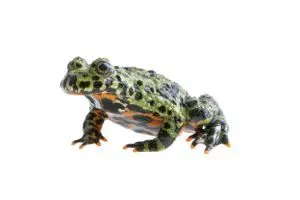
Quick Facts
- Experience Level: Intermediate
- Family: Bombinatoridae
- Scientific Name: Bombina Orientalis
- Common Names: Bombina
- Average Adult Size: 2 inches
- Lifespan: 12-15 years
- Average Price Range: $15-$25
Quick Care Requirements
- Food: Small Insects, Mealworms, Waxworms e.t.c.
- UVB Lighting: Light low level required
- Temperature Range: 82⁰F(day) 62⁰F(night)
- Aquarium/Tank Size: 10 gallons minimum
Orient Fire Bellied Toads are small with a shiny red color and black spots. Again, avoid handling them and if you do wear the proper gloves.
When setting up their aquarium you should avoid using gravel and instead use a coconut fiber substrate.
Cleaning frequency is similar to the others and should be done weekly.
Healthwise you should always monitor your toad to make sure it had clear eyes, healthy skin and is eating regularly.
Similar to the others above they also secrete a toxin which you should be aware of and take precautions from for the rare handling.
Check out the Oriental Fire Bellied toad care sheet for a full breakdown of everything required for good care.
6. OakToad
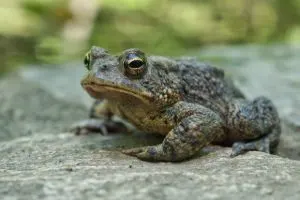
Quick Facts
- Experience Level: Intermediate
- Family: Bufonidae
- Scientific Name: Anaxyrus quercicus
- Common Names: Oak toad, Oakwood toad
- Average Adult Size: 0.75-1.3 inches
- Lifespan: 2-4 years
- Average Price Range: $11-$20
Quick Care Requirements
- Food: Small crickets, Insects, Small roaches
- UVB Lighting: Low-level UVB preferred
- Temperature Range: 75⁰F- 80⁰F
- Aquarium/Tank Size: 10-gallon tank
The Oakwood toad is the smallest in the North American continent. Its color ranges from light grey to brown to black sometimes. Their habitat consists of grassy areas that have moisture near oak savannah in sandy soil.
Decorate the aquarium with a substrate that mimics their habitat. The depth of the aquarium should be a minimum of two inches.
For their environment you it should have a humidy leverl of around 50-60 percent. You can use artificial or natural decorations to try and mimic its natural habitat.
A UVB light can be added to protect against microbial bacteria as well. Lastly you can place a large bowl of chlorine-free fresh water for them to have which should be refreshed regularly.
They are mostly active during the daytime.
7. Tomato Toad
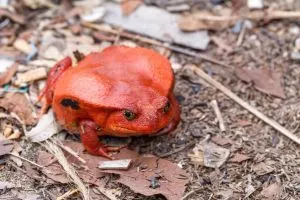
Quick Facts
- Experience Level: Beginner
- Family: Microhylid
- Scientific Name: Dyscophus antongilii
- Common Names: Tomato Frog or Cherry Tomato Frog
- Average Adult Size: 2.5-3.5 inches
- Lifespan: 6-8 years
- Average Price Range: $30-$45
Quick Care Requirements
- Food: Crickets and Nightcrawlers, Fluker freeze-dried bloodworms, small animal food
- UVB Lighting: Not required
- Temperature Range: 65⁰F-80⁰F
- Aquarium/Tank Size: 10-gallon tank for a pair
The Tomato Toad is one of the smallest pet toad species. They can live in a variety of habitats, making them very adaptive and a great option as a pet.
Food wise they only eat live insects like crickets, fly larva, mealworms and so on. When handled, they release white sticky liquid, so like usual just avoid handling them.
These guys like to burrow so their setup should have a deep substrate made up of coconut fiber and soil with a depth of around 2 feet (roughly .5 meters).
The substrate should be replaced around every 2 months or so.
They cope well in pairs as well so it’s a nice option to get two of them. If you get them at the same time from a captive breeder you should be ok in putting them together right away, unless specified otherwise.
If you get them at different times, then you will need to quarantine them initially for around a month and should have them checked out by a vet to make sure they don’t have diseases or parasites.
Another thing to consider is size, as bigger Tomato frogs eat the smaller ones, so they should be around the same size/age when combining them.
See the following guide for a more detailed breakdown about Tomato Frog Care.
Conclusion
Finding the best pet toad really comes down to preference and experience ultimately. Care levels vary with the beginner pet toads being the California toad, American Toad and Tomato toad.
If you have already had a pet toad, or maybe another amphibian the intermediate pet toads could be fine for you and include the Cane toad, fire bellied toad, and the oaktoad.
The last category is for experts, and you should really be well versed in toad care if you go this route. Since our list was more geared to beginners there was only one expert level and that was the Poison dart frog.
Table of Contents
